Archive:Wood as a source of energy
- Data extracted in July 2018. Most recent data: Further Eurostat information, Main tables and Database. Next update of the article: July 2019
This article is part of a set of statistical articles that the Eurostat online publication "Agriculture, forestry and fishery statistics" and other publications are based on. It presents statistics on wood and energy in the European Union (EU).
The European Union (EU) accounts for approximately 5 % of the world’s forests and, contrary to what is happening in many other parts of the world, the forested area of the EU is slowly increasing. One of the ecological aspects of forests is their role as a renewable energy resource. This article presents statistics on the share of wood in the EU's energy consumption as well as the production and trade in wood pellets and other agglomerates (e.g. briquettes).
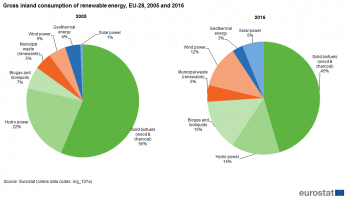
(1 000 tonnes of oil equivalent)
Source: Eurostat (nrg_107a))
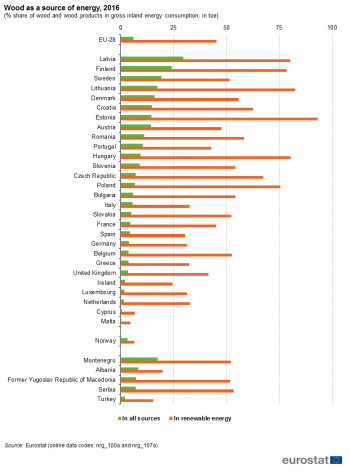
(% share of wood and wood products in gross inland energy consumption, in TOE)
Source: Eurostat (nrg_100a) and (nrg_107a)
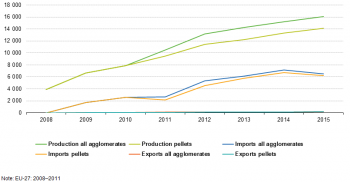
(1 000 tonnes)
Source: Eurostat (for_basic)
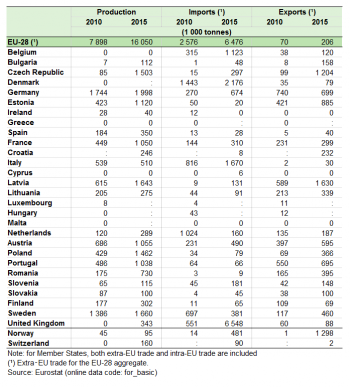
(1 000 tonnes)
Source: Eurostat (for_basic)
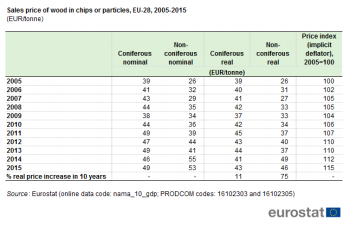
(EUR/t)
Source: Eurostat ( (nama_10_gdp); PRODCOM codes: 16102303 and 16102305 )
Main statistical findings
Fuel wood in the mix of renewables
Energy supply has always been one of the main uses for wood. Policy interest in energy security and renewable sources of energy, combined with relatively high oil and gas prices, has led in recent years to a reassessment of the possible use of wood as a source of energy. The use of renewables is enshrined in legally binding targets that have been set for each EU Member State concerning the role to be played by renewable energy sources through to 2020. The 2016 edition of the indicator report on the Europe 2020 strategy Smarter, greener, more inclusive? provides information on the progress being made towards the target of achieving a 20 % share of renewable energy in final energy consumption by 2020. This goal is designed to help reduce emissions, improve the security of energy supply and reduce dependence on energy imports.
Between 2005 and 2016, the consumption of renewable energy within the EU-28 increased by 78.6 %. Some renewable energy sources grew exponentially. The consumption of solar energy for example, grew by 1 512 % between 2005 and 2016. However, the consumption of more established renewable energy sources, such as biomass other than wood (including municipal waste) also increased substantially (+ 204 %) during the same period. Among renewable energy sources, total biomass (wood and other biomass including municipal waste) plays an important role, accounting for two thirds (65 %) of the gross inland energy consumption of renewables in the EU-28 in 2016. As part of this biomass total, wood and agglomerated wood products such as pellets and briquettes provided the highest share of energy of biological origin, accounting for almost half (45 %) of the EU-28’s gross inland energy consumption of renewables in 2016 - see Figure 1.
In many EU Member States, wood was the most important single source of energy from renewables. As shown in Figure 2, wood and wood products accounted for 6.0 % of the total energy consumed within the EU-28 in 2016. The share of wood and wood products in gross inland energy consumption ranged from over 20 % in Latvia and Finland down to less than 1 % in Cyprus and Malta. Wood was the source for more than three quarters of the renewable energy consumed in Estonia, Lithuania, Hungary, Latvia, Finland, and Poland. By contrast, the share of wood in the mix of renewables was relatively low in Cyprus and Malta (where the lowest share was reported, 4.5 %); this was also the case in Norway (6.4 %).
While the energy statistics on wood used as a renewable source include estimates for the private consumption in tonnes of oil equivalent (TOE), the physical data on removals of fuel wood from the EU's forests are probably under-reported in the Joint Forest Sector Questionnaire (JFSQ) - (see Wood products - production and trade). Denmark, Greece (2014), France, Italy and Cyprus were the only EU Member States where over half of the roundwood produced in 2015 was fuel wood, while Bulgaria, Croatia, Lithuania and Romania reported proportions between 33 % and 45 %. In many EU Member States, however, no estimates of fuel wood consumption by households are included in the numbers reported in the JFSQ. Separate studies would be needed to produce them, because this wood may be acquired informally, including from forests owned by households. The JFSQ data show strong growth in the production and trade in wood pellets and other agglomerates in recent years (see Table 1 and Figure 3), but no corresponding increase in upstream fuel wood production.
Production and trade in fuel wood
Although potential biomass supplies within most EU Member States are substantial, some countries import significant volumes of fuel wood as they seek to meet their renewable energy targets, raising concerns about the consequences this may have on the global sustainability of forests and resulting levels of carbon emissions. According to the COMEXT database, the EU's overall imports from non-EU countries - including logs, chips and particles, sawdust, wood waste and scrap, wood pellets, wood briquettes and similar forms - grew sharply between 2005 and 2015. The quantities increased by approximately 270 % to 14 million tonnes, while their value increased by 635 % to 1542 million EUR. The increase is clearly visible in the article on Wood products - production and trade (Figure 7). The overall price of these imports went from 55 Euro per tonne to 110 Euro per tonne in the same period.
Wood pellets and other agglomerated energy products are made from dried sawdust, shavings or wood powder, with the raw material being compressed under high pressure. Pellets and agglomerates are currently the most economical way of converting biomass into fuel and are a fast-growing source of energy in Europe. They can be used for electricity production or directly for combustion in residential and commercial heating. The EU-28 was the largest global producer of wood pellets, its output reaching an estimated 16.0 million tonnes in 2015; production in the EU-28 rose by 103.2 % overall between 2010 and 2015. Germany produced an estimated 2.0 million tonnes of wood pellets in 2015, or 12.5 %, of the EU-28’s output. Sweden was the second largest producer with 1.66 million tonnes, followed by Latvia (1.64 million tonnes), the Czech Republic (1.5 million tonnes), Poland and Estonia (1.46 and 1.12 million tonnes) (see Table 1).
The EU-28 is also a net importer of wood pellets: the level of imports from non-EU countries rose to 6.5 million tonnes in 2015, an overall increase of 151.4 % compared with 2010. The main suppliers of EU imports were the United States and Canada; much less is supplied by Russia and other countries (i.a. Belarus and Ukraine). The United Kingdom was the biggest importer of wood pellets in 2015 among the EU-28 Member States, with some 6.5 million tonnes (note that this figure relates to total imports, from non-EU countries as well as from Member States). Denmark and Italy imported respectively around 2.2 million tonnes and 1.7 million tonnes of wood pellets in 2015. By contrast, Latvia was the only EU Member State to export more than 1.6 million tonnes of wood pellets in 2015, followed by the Czech Republic with 1.2 million tonnes and Estonia with 885 thousand tonnes. The Czech Republic also exported 490 thousand tonnes of other agglomerates, such as wood briquettes [1].
Material use competes with energy use
Table 2 and Figure 4 show the real price increases of wood chips and particles over 10 years. Two products are available, coniferous and non-coniferous wood chips and particles. Both can be used for the production of wood panels such as particle board and as energy products. While the price index used in national accounts increased by 15.3 % and the harmonised index of consumer prices increased by 19.2 % over the same period, real prices for the coniferous product increased 10.7 % and real prices for the non-coniferous product increased 74.9 %. This shows that there is strong competition particularly for non-coniferous chips and particles, which may have been exacerbated by subsidies for the use of such wood for energy production. In 2015, the average EU-28 import price from third countries was comparable to the price for production sold for the coniferous product (41 EUR/t), while the average import price for the non-coniferous product was much higher at 78 EUR/t, according to Eurostat's external trade database COMEXT. Per cubic metre of bulk volume, non-coniferous wood has a higher calorific value than coniferous wood because it is denser and hence will burn longer, see the CA-RES Quality standard for statistics on wood fuel consumption of households (2012), p. 22.
Data sources and availability
Eurostat, the Timber Committee of the United Nations Economic Commission for Europe (UNECE), Forestry Section of the United Nations Food and Agriculture Organisation (FAO) and the International Tropical Timber Organisation (ITTO) collect and collate statistics on the production and trade of wood through their Joint Forest Sector Questionnaire. Each partner collects data from a different part of the world; Eurostat is responsible for the data collection exercise pertaining to the EU Member States and EFTA countries.
Eurostat produces annual data on forestry using two questionnaires:
- The Joint Forest Sector Questionnaire (JFSQ)on production and trade in wood and wood products;
- European Forest Accounts (EFA), forming part of an environmental satellite accounts initiative that started in the late 1990s.
The JFSQ provides data for supply balances of timber used for wood products and for energy, and for estimating the carbon contained in harvested wood products.
Renewable energy statistics are based on annual energy statistics defined in Regulation (EC) No 1099/2008 . All countries should include estimates of the consumption of energy from wood by households, using any method (survey is one of the options, modelling is also used).
Context
A broad array of EU policies and initiatives have a bearing on forests. For several decades, environmental forest functions have attracted increasing attention — for example, in relation to the protection of biodiversity and, more recently, in the context of climate change impacts and energy policies. Apart from the traditional production of wood and other forest-based products, forests are increasingly valued for their environmental role and as a public amenity. The EU promotes sustainable forest management, aiming to
- create and preserve jobs and otherwise contribute to rural livelihoods;
- protect the environment by preserving the soil, minimising erosion, purifying water, protecting aquifers, improving air quality, absorbing carbon, mitigating climate change, and preserving biodiversity;
- monitor the state of forests to meet environmental agreements;
- improve the competitiveness of forest-based industries in the internal market;
- promote the use of wood and other forest products as environmentally friendly products;
- reduce poverty in developing countries by furthering forest law enforcement, fair trade conditions and halting deforestation and illegal logging.
The European Commission presented a new EU forest strategy (COM(2013) 659) for forests and the forest-based sector in 2013, in response to the increasing demands put on forests and to significant societal and political changes that have affected forests over the last 15 years. The strategy is a framework for forest-related measures and is used to coordinate EU initiatives with the forest policies of the Member States. In March 2010, the European Commission adopted a Green paper on forest protection and information in the EU: preparing forests for climate change (COM(2010) 66 final). The paper aimed to stimulate debate concerning the way climate change modifies the terms of forest management and protection, and how EU policy should develop as a consequence.
Forestry, along with farming, remains crucial for land use and the management of natural resources in the EU’s rural areas, and as a basis for economic diversification in rural communities. Rural development policy is part of the EU’s common agricultural policy (CAP) which has been the main instrument for implementing forestry measures in recent years. In this context, it is estimated that spending on forest-related measures — through the European Agricultural Fund for Rural Development — amounted to EUR 9–10 billion during the period 2007–13.
See also
- Agriculture, forestry and fishery statistics
- The EU in the world - agriculture, forestry and fisheries
- Wood products - production and trade
- Forests, forestry and logging
- Forestry and climate change
Further Eurostat information
Publications
- Agriculture, forestry and fishery statistics — 2015 edition (Statistical book)
- Energy, transport and environment indicators — 2016 edition (Pocketbook)
- Environmental statistics and accounts in Europe — 2010 edition (Statistical book)
- Forestry in the EU and the world — 2011 edition (Statistical book)
Main tables
- Forestry (t_for), see:
- Economic accounts for forestry and logging - values at current prices (tag00058)
- Roundwood production (tag00072)
- Total sawnwood production (tag00073)
- Total paper and paperboard production (tag00074)
- Forest increment and fellings (tsdnr520)
Database
- Forestry (for), see:
- Removals, production and trade (for_rpt)
- Roundwood removals (for_rptr)
- Roundwood production and trade (for_rptt)
- Production and trade in primary products (for_rptp)
- Trade in secondary processed products (for_rpts)
- Economics and Employment (for_eaf)
- Integrated Environmental and Economic Accounting for Forests (for_ieeaf)
- Historical Economic Accounts for Forestry (Series end in 2005) (for_eafh)
- Sustainable forest management (for_sfm)
- Assets (for_sfmas)
- Environmental aspects (for_sfmen)
- Energy (nrg), see:
- Energy statistics - quantities, annual data (nrg_quant)
- Energy statistics - supply, transformation and consumption (nrg_10)
- Simplified energy balances - annual data (nrg_100a)
- Supply, transformation and consumption of renewable energies - annual data (nrg_107a)
- Energy statistics - supply, transformation and consumption (nrg_10)
Dedicated section
Methodology / Metadata
- Forestry [ESMS metadata file - for_esms]
Source data for tables and figures (MS Excel)
Other information
- Joint Forest Sector Questionnaire (JFSQ)
- European Forest Accounts (EFA)
- Manual on the Economic Accounts for Agriculture and Forestry EAA/EAF 97 (Rev.1.1)
External links
- European Union Forest Action Plan
- Food and Agriculture Organization of the United Nations (FAO) - Forestry
- Forest-based sector European Technology Platform
- International Tropical Timber Organisation (ITTO)
- United Nations Economic Commission for Europe (UNECE) - UNECE / FAO Timber Section
